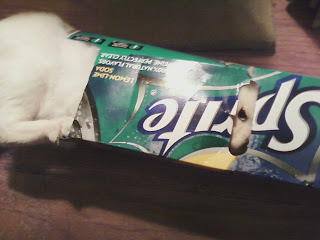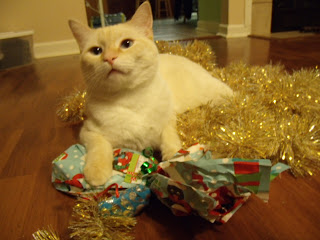 |
| "What do you mean midnight is still six hours away? I've already drunk all the sparkling cider!" |
What has become a newer tradition, however, is pet owners making up resolutions for their cats, or cats making resolutions for themselves. Some of these resolutions are funny, while others are more serious.
Following are some resolutions cats have made for themselves on Joke Archives:
"I will not puff my entire body to twice its size for no reason after my human has finished watching a horror movie."
"I will not fish out my human's partial plate from the glass so that the dog can 'wear' it and pretend to be my human. (It is somewhat unnerving to wake up, roll over in bed, and see the dog grinning at you with your own teeth.)"
"I will not use the bathtub to store live mice for late-night snacks."
"I will not walk on the keyboard when my human is writing important emiognaioerp ga3qi4 taija3tgv aa35 a."
and Finny's favorite, "I will not eat large numbers of assorted bugs, then come home and puke them up so the humans can see that I'm getting plenty of roughage."
Catster.com also lists a few resolutions for cats, but they are actually good advice for cat-owners. The list includes four changes to implement in your kitty's life to make it happier and healthier. Lose weight, exercise more, eat better, and always go for vet checkups. If "vet" were changed just to "doctor," this list sounds a lot like most peoples' new year's resolutions are. That just goes to show that living healthier is always best for pet and owner alike.
Inspired by these internet findings, Finnegan has decided to make his own new year's resolutions.
"I will not sleep with my eyes open and freak out my owners anymore."
"I will not stuff myself into soda can boxes then roll around the floor like a snake."
"I will sit still when Aunt Elizabeth is trying to take pictures of me."
"I will not help myself to treats, even when they are left out on the coffee table."
Even though he's made these resolutions, something tells me that Finny won't be following them for long!
 |
Finny's final resolution should have been, "I will not nibble on the Christmas tree next year."
Happy "Mew" Year from Finnegan and Rebecca Jane!
~RL



















